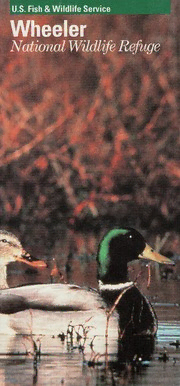
Wheeler National Wildlife Refuge Pamphlet (1997) PDF
Preview Wheeler National Wildlife Refuge Pamphlet (1997)
Wheeler National Wildlife Refuge was established in 1938 as a wintering area for ducks, geese and other migratory birds. Today the refuge is one of over 500 refuges in the National Wildlife Refuge System administered by the U.S. Fish and Wildlife Service. Migrating Waterfowl This 34,500 acre refuge attracts thousands of wintering waterfowl each year. The refuge hosts 115 species of fish, 74 species of reptiles This blue goose, and amphibians, 47 species of designed by Ding mammals, and 285 different species Darling, has of songbirds. The refuge also become a symbol manages and protects habitat for 10 of the Refuge federally listed endangered or System. threatened species that reside on the refuge. Wheeler National Wildlife Refuge is comprised of a great diversity of habitat types such as bottomland hardwoods, wetlands, pine uplands, shoreline or riparian woodlands, agricultural fields, and back water embayments. These habitats provide excellent feeding, loafing and roosting sites for wintering waterfowl, as well as nesting sites for seasonally migrating songbirds. cover photo: David McEwen © Management techniques on the refuge include: Waterfowl Food Approximately 3500 acres of crop¬ Production land are cultivated by local farmers on a share agreement. During harvest a portion of the crop is left in the field as a food source for ducks, geese, and other wildlife. Each fall the refuge provides green browse for wintering geese by planting wheat. Water Control Water control structures are used in wet areas to change water levels in a controlled manner. This type of management provides food for waterfowl by encouraging the growth of native plants in moist areas. Providing Habitat Diversity Wheeler Refuge’s wide variety of habitat types are managed to produce as much quality food and cover as feasibly possible for wildlife. Banding Ducks and other birds are banded each year in an effort to maintain current information on nesting success, harvest numbers, migration routes, and the general condition of populations. Use by the Public The public is encouraged to visit the refuge and participate in the many activities designed and offered for outdoor enjoyment. Wildlife observation, fishing, hiking, nature study, and hunting of small game and deer are just a few of the opportunities available. The Visitor Center located on Highway 67, two miles west of 1-65, should be the first stop for all visitors planning a trip to the refuge. At the Visitor Center, visitors can obtain information about the refuge, enjoy the exhibits, watch the orientation video, use the observation building and trails, and find out about other interesting activities that might be available. — Refuge Lands Within Redstone Arsenal = Highways — Roads Whee — Refuge Boundary IB Visitor Center National Wildlif o Wildlife Observation Boating Flint Creek Environmental ★ Area & Disabled Persons Fishing Pier Enjoy Your Visit Q Visitor October 1-February 28 Center Hours Daily 10:00 am-5:00 pm March 1-September 30 W10e:0d0n aemsd-a5y:0-S0 upnmd ay Q Wildlife Permitted year-round. Observation An observation building and platform is provided for your o enjoyment. Fishing Open to fishing subject and Hunting to State regulations; o managed hunts are held for small game and deer. Permit required. o Boating Permitted. Six improved boat¬ launching ramps available. Water skiing a restricted and personal watercraft prohibited. Bicycles Permitted on graveled roads only. Horses and Permitted on open Mule Riding graveled roads. Not permitted on refuge hunts. Vehicles Only licensed vehicles permitted. No . unlicensed ATV’s. Access is limited to n graveled roads and a portion of these are closed at certain times. Firearms Prohibited, except on managed hunts. - Camping Not permitted. Artifact Surface and subsurface Collecting collecting is prohibited. Calendar of Wildlife Events This calendar is meant to serve as a guide to general wildlife events for visitors. Weather and fluctuating water levels may cause variations in these events. January Waterfowl numbers are at their peak during the first half of the month. Canada and snow geese are abundant along with many species of ducks; mallards are the most abundant. Waterfowl begin moving north by the end of the month. February Waterfowl numbers begin to decline rapidly. Wood duck nesting begins. Depending on the weather, fishing can be good by the end of the month. March Waterfowl numbers are low, but a variety of species can still be seen. Blue-winged teal and shorebirds begin migrating. Turtles are present on sunny days. Crappie fishing is at its best. April Teal migration is at its peak. Warblers, vireos, and other small passerine birds are migrating. Migrant songbird nesting is in full progress. Wild flowers are at their peak. May Broods of wood ducks, mallards, and black ducks appear. Young songbirds and rabbits begin to appear. The last
